Weekend trip! Fukui and Kanazawa 2 days and 1 night (using Hokuriku Shinkansen and regular sightseeing bus)
Why not enjoy a trip to Fukui and Kanazawa using the Hokuriku Shinkansen Line, which has extend to Fukui in March 2024?
Fukui's major sightseeing spots are scattered throughout the prefecture, but you can tour them efficiently and comfortably with a guide by using the "Hapi Bus," a regular sightseeing bus that operates on weekends and holidays.
The "Hapi Bus" operates even for one person. If there is space available on the day of the tour, you may take the bus, but advance reservations are recommended.
Kanazawa's sightseeing spots are all within a 2-kilometer radius, allowing for a compact sightseeing tour on foot or by bus.
Keywords
●"Public transportation"
●"Zen" Eiheiji Temple, a Zen sanctuary that Apple founder Steve Jobs admired
●"Existing castle tower" Maruoka Castle, one of the 12 remaining castle towers in Japan
●"National Special Place of Scenic Beauty", "National Special Historic Site" The ruins of the Ichijodani Asakura clan, designated as both
●"Japan's top 100 castles" Maruoka Castle, Kanazawa Castle
●"Japan's Three Famous Gardens" Kenrokuen
●"Chaya District" Higashi Chaya District, one of the most famous photo spots in Kanazawa
●"The best market in Hokuriku" Ohmicho market, the sight of 170 stores in a row is breathtaking
(To search for accommodations, go to the accommodations page.)
we introduce a model course using Hapi Bus as sightseeing in Fukui.
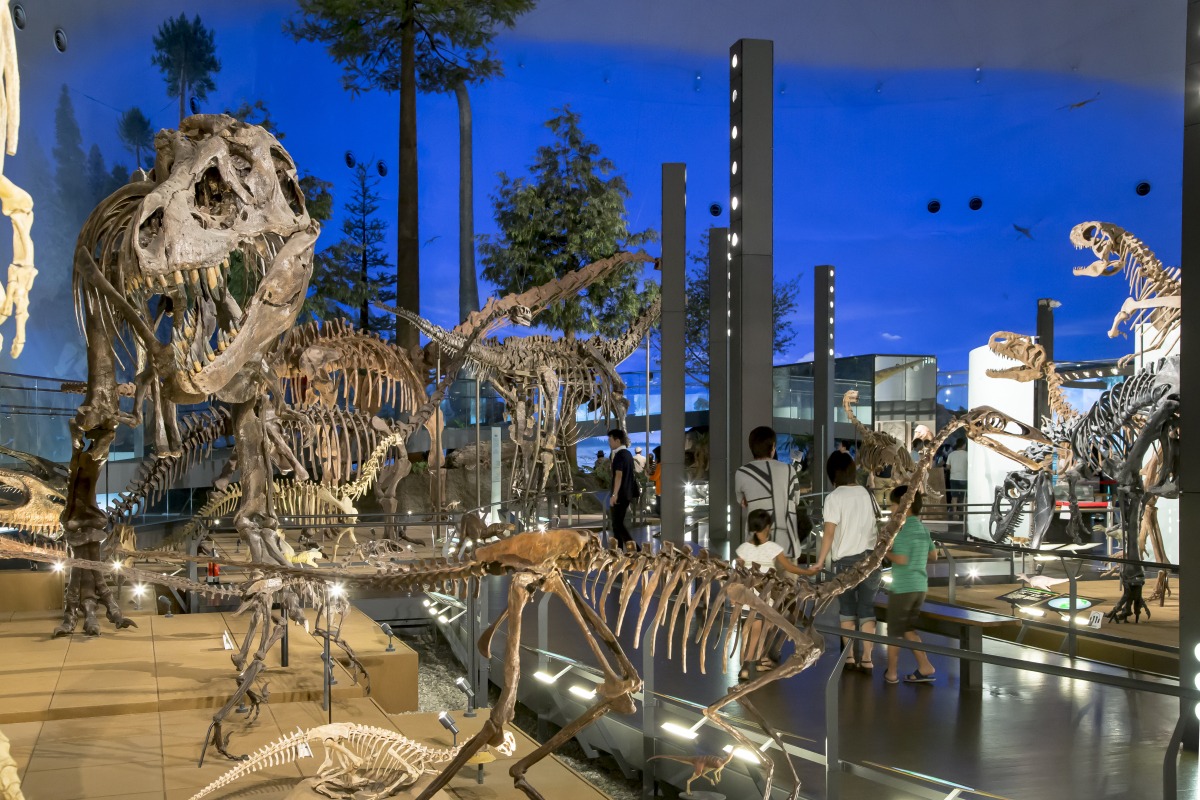
[Hands-Free Travel] Baggage Delivery Service
Leave your luggage at the Kanazawa Station Tourist Information Center and go sightseeing without it!
This is a fee-based service where you can leave your baggage at Kanazawa Station and we will deliver it to your hotel or ryokan on the same day. You want to go sightseeing as soon as you arrive at Kanazawa Station! This service is recommended for those who have a lot of luggage for the trip. The service counter is located at the Kanazawa Station Tourist Information Center.
Delivery area: Kanazawa City, Noto area, hot springs in Kaga area, and hotels and inns in Awara City, Fukui Prefecture.
![[Hands-Free Travel] Baggage Delivery Service](/lsc/upfile/courseDetail/0000/1276/1276_1_m.jpg)
↓walking (about 12 min) or take a local bus or Kanazawa Shuyu Bus (left route) from Kanazawa Station East Exit (Kenrokuen Exit) to Ohmicho market (approx. 5 min.).
Get off at the bus stop "Musashigatsuji/Ohmicho market".
Omicho Market
Discover Kanazawa’s most famous fish market
Established during the Edo Period, Omicho Market has formed an essential part of Kanazawa’s food culture for more than 300 years.
The sprawling market features more than 170 stores, including a large number of fishmongers that sell freshly caught seafood from the Sea of Japan. There are also fruit and vegetables stores that sell unique local produce, marine product stores, clothing stores, grocery stores and restaurants.
Particularly well-revered are the crab, yellowtail and shrimp from the Sea of Japan that are sold around November. Because of this, the market is normally crowded with tourists and locals alike during this time of year.
Another key attraction of the market is Omicho Ichibakan. The refurbished building features a number of popular restaurants and stores that are worth stopping by during your trip to the market.
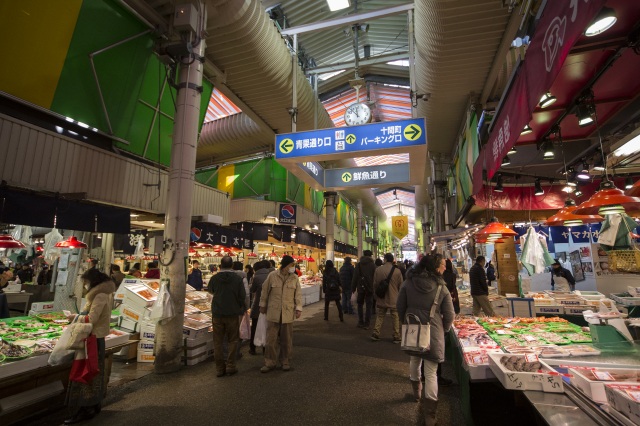
↓Walking (about 15-20 minutes) or by bus (about 5 minutes)
Bus stop "Hashiba-cho"
5-minute walk from Hashiba-cho bus stop to Higashi Chaya district
Higashi Chaya District
Discover one of Kanazawa’s largest geisha districts
In Japanese culture, geisha houses have been traditional places for feasts and entertainment since the Edo period. Also referred to as “chaya”, they are where geishas entertained wealthy nobility and rich merchants. Geishas are female Japanese entertainers who perform dances and play traditional Japanese instruments.
The central part of Kanazawa was once dotted with a number of geisha houses, but in 1820, these were moved to three specific districts away from the city centre. The largest one of these – and arguably the most famous – is the Higashi Chaya district.
The geisha houses in Higashi Chaya have a stunning traditional appearance. A geisha house is characterised by the beautiful lattice on the outer side of its first floor, called “kimusuko”, and the Japanese-style guestrooms located on the second floor. During the Edo period, the construction of two-story buildings except geisha houses was prohibited, making their appearance all the more striking.
These historical geisha houses along with Kyoto's Gion and Kanazawa's Kazue-machi have been designated as Japanese cultural assets. No other geisha districts have been designated as cultural assets for Japan, making Higashi Chaya even more special.
The district includes facilities where you can see the interior of a geisha house that was built almost 200 years ago, as well as quite a few old buildings have been refurbished into restaurants, cafes, and souvenir shops. Additionally, it takes a mere three minutes on foot to reach the banks of the Asano River from Higashi Chaya, making it an excellent area to explore afterwards.
The Kanazawa City Tourism Association holds a geisha performance show in the three geisha districts of the city on designated Saturdays, so make sure you plan your visit accordingly.
Click here for stores in Higashi Chaya District where you can use the special Gourmet Ticket Kanazawa Bimi.
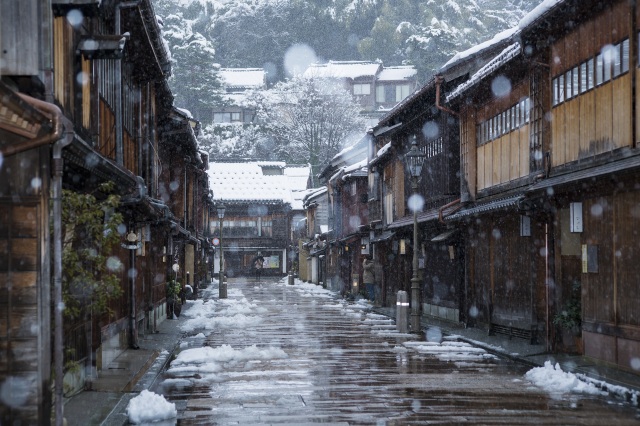
↓Take a local bus or Kanazawa excursion bus to Kenrokuen Garden and Kanazawa Castle (5 min.)
Get off at bus stop "Kenrokuen-shita/Kanazawa Castle"
Kenrokuen Garden
A Beautiful and Famous Garden in the Heart of Kanazawa
Considered one of Japan’s three most beautiful gardens, Kenrokuen Garden is a must-visit location in Kanazawa. The name Kenrokuen means “having six factors”, representing the attributes which bring out the garden’s stunning beauty: spaciousness, tranquility, artifice, antiquity, water sources and magnificent views.The garden has an area of 11.4 hectares and is located on the heights of the central part of Kanazawa next to Kanazawa Castle. The Maeda family, who ruled the Kaga Domain (the present Ishikawa and Toyama areas) in feudal times, maintained the garden from generation to generation. It is regarded as one of the most beautiful feudal lords' gardens in Japan.
One of Kenrokuen Garden’s most stunning attractions is its large artificial pond called Kasumigaike. Located near the center of the pond is Horai Island. The pond is often seen to symbolize the sea and Horai Island a sacred island out at sea, on which an ageless hermit with miraculous power was believed to live. As a result, the pond and the island were constructed to symbolize long life and eternal prosperity for the lord.
There are many other gorgeous features to enjoy in the garden, including the flowers and trees that grow there, such as plum and cherry blossoms in spring, azaleas and irises early in summer, and colorful red and yellow leaves in autumn.
In Winter, visitors can enjoy the snow-covered landscapes with yukitsuri (which means “snow hanging”). yukitsuri is a traditional technique for protecting the branches of the pine trees in the garden from heavy snow; trees are given support by bamboo poles and rope arranged a captivating conical layout.
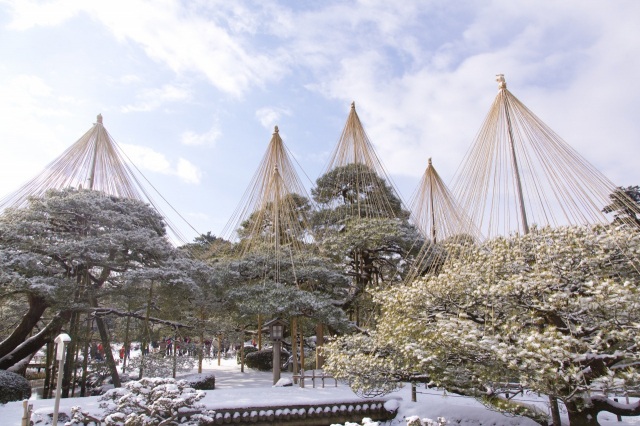
↓About 5min
21st Century Museum of Contemporary Art, Kanazawa
21st Century Museum of Contemporary Art, Kanazawa
A hub for contemporary art in Kanazawa
Opened in 2004, the 21st Century Museum of Contemporary Art in Kanazawa stands out compared to more traditional art museums. The museum features a captivating disc-like design, as if it were a UFO touching down in the middle of Kanazawa. All the walls are made of glass and the building features five gates, all pointing towards different parts of the city.
The museum exhibits experimental contemporary art that visitors can touch or sit on and is perfect for children and adults alike. Some of museum’s highlights include commissioned works, which are integrated into the building’s unique design.
The 21st Century Museum of Contemporary Art excels at offering visitors unique experiences that can’t be found anywhere else. Highlights include Leandro Erlich's The Swimming Pool, which enables visitors to feel as if they’re standing at the bottom of a swimming pool, and a wall decorated with flowers gathered from the suburbs of Kanazawa.
Additionally, the museum's shop offers a wide variety of products, such as museum memorabilia, accessories, and selected goods.
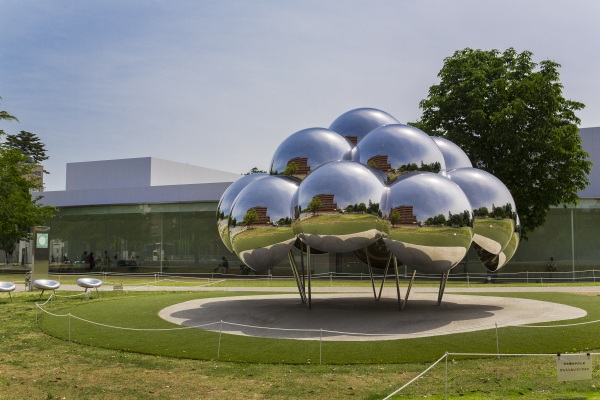
↓ 15 minutes on foot
Ruins of Naga-machi Samurai Residence
Nagamachi District
A stunningly preserved samurai district in the center of Kanazawa
Kanazawa was once the economic and administrative center of the Kaga Domain (feudal-era Ishikawa Prefecture). Over the course of the Edo period, it grew rapidly – its population growing to over 100,000 – transforming it into one of the largest castle towns in feudal Japan. Its population rivaled that of Rome and Madrid at the time.
With the castle at its center, the town was designed with both its defensive and economic aspects in mind. Members of the upper classes were often given allotments of land for their residences close to that of the feudal lord (daimyo) in the castle, while commoners lived near the town’s edges.
Nagamachi Samurai District, located near the center of town, was where the middle to high-ranking samurais lived – which is why it’s sometimes described as the city’s samurai district. Nagamachi literally means “Long Town,” though it’s more likely that it actually takes its name from the surname of a local family, the Cho, which means “long” which can also be pronounced “naga.”
Nagamachi Samurai District’s historical value lies in its unusual state of preservation. It has escaped large-scale fires, including the firebombing that damaged other large cities such as Tokyo and Osaka during World War II. Accordingly, it retains many features from the Edo period: narrow streets, a drainage and water supply system that remains in use, and restored samurai houses.
Many of these residences maintain their original earthen walls (tsuchi-kabe), which are still covered in the winter with straw mats to protect them from frost and subsequent cracking. A walk through Nagamachi, where an Edo-period atmosphere still lingers, offers a glimpse into the heritage of Kanazawa and Japan.
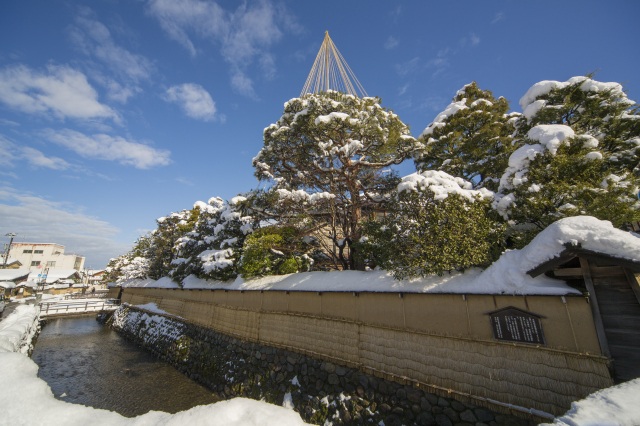
Kanazawa Station 7:02 Hokuriku Shinkansen Tsurugi 5
↓
Fukui Station 7:37
Arrive at JR Fukui Station East Exit (Ichijyodani Exit)
Fukui round-trip bus "Happibus"
Let's tour around Fukui comfortably by "Happi Bus", a regular sightseeing bus (operated on Saturdays, Sundays, and holidays from March 16 to November 30, 2024)!
Course A
9:00 Depart from JR Fukui Station East Exit (Ichijodani Exit)
↓
Fukui Prefectural Dinosaur Museum Tour (90 min.)
*105 min. from December 2025 to March 2026
↓
Echizen Great Buddha visit (60 min.)
(*The tour will be changed to Heisenji Hakusan Shrine from March to November 2025, and to Echizen Daibutsu Buddha (55 min.) from December to March 2026.
↓
13:00 Arrive at JR Fukui Station East Exit (Ichijodani Exit)
※Please bring your own snacks as there will be little time for lunch.
Course B
13:20 Depart from JR Fukui Station East Exit (Ichijodani Exit)
↓
Visit Eiheiji Temple (70 min.)
↓
Ichijodani Asakura Clan Historic Ruins(45 min.)
↓
Ichijodani Asakura Family Museum (40 min.)
↓
17:20 Arrive at JR Fukui Station East Exit (Ichijodani Exit)
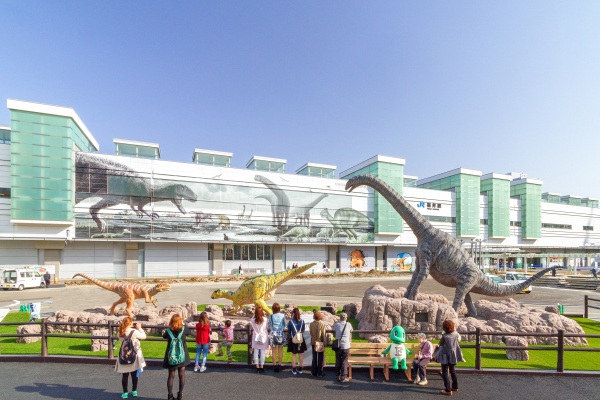
Depart Fukui Station 18:54 Hokuriku Shinkansen (Kagayaki 516)
Arrive at Tokyo Station at 21:56
18:19 Hokuriku Shinkansen (Tsurugi 39) from Fukui Station
Tsuruga Station 18:36
18:44 JR Hokuriku Line (Thunderbird No. 40)
Arrive at Osaka Station 20:09